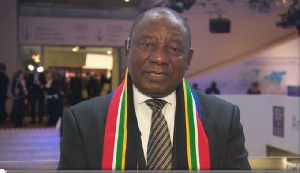 South African President Cyril Ramaphosa
South African President Cyril Ramaphosa
South African President Cyril Ramaphosa is visibly torn between two forces in his intervention in the conflict in the Democratic Republic of Congo.
At home, he faces a crucial election next month that will test the ability of the ruling African National Congress’s stranglehold on power.
Yet his country is also leading the Southern African Development Community Mission in Congo (SAMIDRC), deployed in the east of the DRC to combat rebel groups, principally the M23.
The South African head of state is now preaching a search for peace through political and diplomatic negotiations in the war between the M23 and Kinshasa.
While in Kigali to commemorate the 30th anniversary of the Rwandan genocide, Ramaphosa spoke of the virtue of political dialogue in the Great Lakes conflict, a possible change of tack that may reflect the realities on the ground.
That came as a surprise to many in the DRC.
“This contrasts with his firm stance expressed during his participation in the last African Union summit [last February],” Christopher Ngoyi, a Congolese civil society leader close to the government in the DRC said.
“For Congolese civil society, Ramaphosa’s call for negotiations is a major U-turn.”
Ngoyi has strongly criticised the South African president, while the Congolese authorities have kept a cautious and modest silence on that position. As part of the SADC force in the DRC, South Africa has deployed 2,900 soldiers alongside Tanzanian and Malawian contingents. The SAMIDRC replaced the East African Regional Force in December.
In the minds of Congo authorities, the aim was to have an offensive force to take the place of the EACRF, which the Congolese criticised for not fighting the rebels.
“SAMIDRC is different,” declared then Deputy Prime Minister for Foreign Affairs, Christophe Lutundula in March. “SADC troops support the DRC. Ask the Congolese soldiers, they’ll tell you.”
The Congolese minister was confident: “In the coming days, you will see what happens. It’s not like those who arrived here, the EACRF, who as soon as they landed in Goma started saying that we didn’t come to fight; we came to be a buffer force and started negotiating with the M23. SAMIDRC won’t do that.”
Recent communication from the SADC suggests that the mission is under a certain amount of political pressure.
Will Ramaphosa’s new approach have an impact on the behaviour of troops in the theatre of operations?
On Tuesday, he got to Uganda, where he held talks with President Yoweri Museveni. Like most of the region’s leaders, the Ugandan president had already proposed in July 2022 that the war in the DRC be resolved once and for all.
“My proposal for resolving this problem completely is this: put in place a ceasefire, no more fighting, then we will find a solution.”
The South African president later visited South Sudan where he met with President Salva Kiir.
Now the fighting is raging, and no one is really talking about a ceasefire anymore.
Attempts to reactivate the peace talks are currently without any convincing results. Just a while ago, in February and March, the chairperson of the East African Community, President Salva Kiir, undertook a tour in search of peace in the region and visited Kigali, Bujumbura, Kinshasa and Luanda on the debacle in the DRC, where he was received by President João Lourenço, who is leading the talks between Rwanda and the DRC.
Virtually all the leaders have stated that they wish to resume the dialogue that has now broken down. President Salva Kiir returned to Juba. And it was in this city that he received President Cyril Ramaphosa on Wednesday. The two men again discussed the thorny issue of the search for peace in the region and its elusive contours.